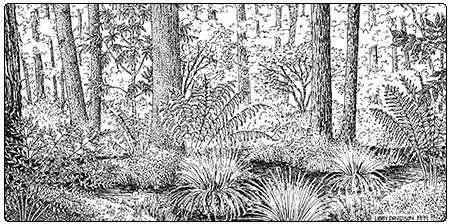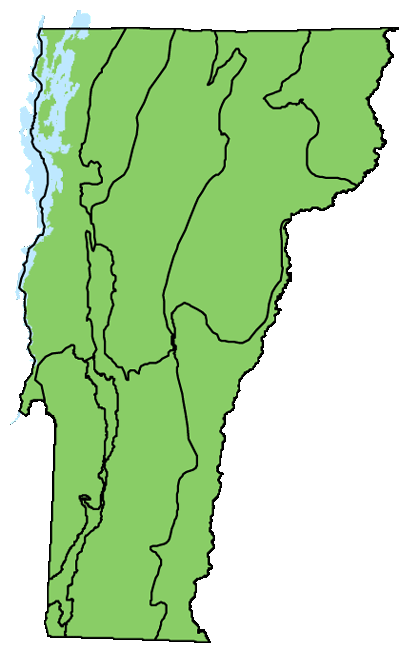Ecology and Physical Setting
The emerald summer canopies of these hardwood swamps are some of the first to turn crimson in the early days of fall. Red Maple-Black Ash Seepage Swamps occur throughout Vermont and are most common in the lower elevations of the Champlain Valley, the Piedmonts, and the Taconic Mountains.
Groundwater seepage is a defining feature of Red Maple-Black Ash Seepage Swamps. It is evident as springs, seeps, and upwellings at the upslope swamp margins. Because of the abundance of seepage water entering the swamp, shallow flowing water typically meanders between the tree bases and hummocks. Red Maple-Black Ash Seepage Swamps are commonly the headwaters for small perennial streams, which supply cool waters that are so important for many aquatic species. The chemical nature of groundwater seepage varies with underlying bedrock and surficial geologic deposits. Even in areas with acidic bedrock, seepage delivers some dissolved minerals to the swamp. In areas of calcareous bedrock, Red Maple-Black Ash Seepage Swamps may have exceptionally high plant richness.
 Red Maple-Black Ash Seepage Swamps occur in a variety of topographic settings, from basins to slope-bases to stream sides. The shape of the basin in which the swamp occurs, and the amount and seasonality of groundwater discharge, are primary factors influencing soil development. In deep basins with constant supplies of water, deep organic soils are present. Most Red Maple-Black Ash Seepage Swamps have organic soils greater than 40 inches deep. These organic soils are usually well decomposed. In shallow basins and sloping settings with intermittent soil saturation, organic matter can periodically dry out and decompose, so peat accumulations are shallow. Tall hummocks and wet hollows punctuate these swamps. Natural disturbance varies from individual tree blow-downs to extensive inundation by beavers. These forested wetlands vary in size from a few acres to over 900 acres.
Red Maple-Black Ash Seepage Swamps occur in a variety of topographic settings, from basins to slope-bases to stream sides. The shape of the basin in which the swamp occurs, and the amount and seasonality of groundwater discharge, are primary factors influencing soil development. In deep basins with constant supplies of water, deep organic soils are present. Most Red Maple-Black Ash Seepage Swamps have organic soils greater than 40 inches deep. These organic soils are usually well decomposed. In shallow basins and sloping settings with intermittent soil saturation, organic matter can periodically dry out and decompose, so peat accumulations are shallow. Tall hummocks and wet hollows punctuate these swamps. Natural disturbance varies from individual tree blow-downs to extensive inundation by beavers. These forested wetlands vary in size from a few acres to over 900 acres.
Vegetation
Red maple is typically the most abundant tree in the open canopy of these swamps. Black ash is a co-dominant tree species and is highly characteristic of the community type, reflecting the presence of mineral-enriched groundwater. Yellow birch, American elm, scattered hemlock, and tall, emergent white pine are often present as well. Typical shrubs include winterberry holly, dwarf raspberry, northern arrowwood, speckled alder, and in warmer regions, spicebush, highbush blueberry, and poison sumac.

Seepage Swamp.
Cinnamon fern is typically very abundant. Sensitive fern, goldthread, Canada mayflower, royal fern, marsh fern, and crested fern are also common. Herbaceous species, including fowl manna grass, water avens, bristle-stalked sedge, foamflower, swamp saxifrage, golden saxifrage, naked mitrewort, and spotted touch-me-not, reflect the mineral enrichment from groundwater seepage. Several bryophyte species are also indicative of mineral enrichment. These include Thuidium delicatulum, Climacium dendroides, Rhytidiadelphus triquetrus, and Calliergon cordifolium in wet hollows. The more acidic, raised hummocks often support Sphagnum centrale, Sphagnum palustre, and the liverwort Bazzania trilobata.
Wildlife Habitat
The combination of groundwater seepage, abundant water, and a hardwood canopy make Red Maple-Black Ash Seepage Swamps important habitat for many wildlife species. Northern dusky salamanders are found in the cool seepage areas at swamp margins and in headwater streams flowing through and out of these swamps. They venture away from seepage and open water only during wet weather. Some Red Maple-Black Ash Seepage Swamps have pools large enough to provide breeding habitat for spotted salamanders, wood frogs, and Jefferson’s salamanders. Four-toed salamanders are likely to be found in swamps with abundant sphagnum moss.
Breeding birds include northern waterthrush, veery, and Canada warbler. Wood ducks will nest in tree cavities of larger trees in swamps with lots of water or near ponds or rivers. Red-shouldered hawks prefer mature hardwood swamps and riparian areas. They select large trees and build platform nests of sticks high in the tree, but always hidden below the treetops.
Two odonates, eastern red damsel and delta-spotted spiketail, are both closely associated with groundwater seeps and resulting small streams.
Related Communities
- Calcareous Red Maple-Tamarack Swamp is also a seepage swamp but has an open canopy of red maple and tamarack, and herb and bryophyte layers resembling a Rich Fen.
- Hemlock-Balsam Fir-Black Ash Seepage Swamp is also a seepage swamp with many of the same herbaceous indicators of groundwater seepage, but with a canopy co-dominated by hemlock and/or balsam fir.
- Maple-Green Ash Swamp is typically associated with seasonal flooding rather than groundwater seepage, and green ash is a co-dominant with red and/or silver maple.
- Red Maple-Sphagnum Basin Swamp occurs in small isolated basins and typically lacks inlet or outlet streams or groundwater seepage. Red maple dominates the canopy over a carpet of Sphagnum. Plants indicative of groundwater seepage are absent.
Conservation Status and Management Considerations
Red Maple-Black Ash Seepage Swamps are widespread in Vermont but relatively few are protected on conserved public land. We recommend that high quality examples be identified for permanent conservation. Given that the total area occupied by Red Maple-Black Ash Seepage Swamps is small and that these swamps make great contributions to Vermont’s biological diversity, high quality examples on both public and private lands should be allowed to mature under natural ecological processes without timber harvesting. Even in deep winter, organic soils saturated by groundwater seepage may not be fully frozen. Heavy machinery could cause deep rutting that will alter swamp hydrology.
Distribution/Abundance
Red Maple-Black Ash Seepage Swamps are widespread and occur in all biophysical regions, generally below 1,800 feet. They are least common in the Green Mountains. Similar communities occur across the Northeast.
Characteristic Plants
Trees
Abundant Species
Red maple – Acer rubrum
Black ash – Fraxinus nigra
Occasional to Locally Abundant Species
Yellow birch – Betula alleghaniensis
American elm – Ulmus americana
White pine – Pinus strobus
Eastern hemlock – Tsuga canadensis
Shrubs
Occasional to Locally Abundant Species
Winterberry holly – Ilex verticillata
Arrowwood – Viburnum dentatum
Dwarf raspberry – Rubus pubescens
Speckled alder – Alnus incana
Highbush blueberry – Vaccinium corymbosum
Spicebush – Lindera benzoin
Poison-sumac – Toxicodendron vernix
Musclewood – Carpinus caroliniana

Herbs
Abundant Species
Cinnamon fern – Osmundastrum cinnamomeum
Occasional to Locally Abundant Species
Sensitive fern – Onoclea sensibilis
Goldthread – Coptis trifolia
Canada mayflower – Maianthemum canadense
Royal fern – Osmunda regalis
Marsh fern – Thelypteris palustris
Crested woodfern – Dryopteris cristata
Fowl manna grass – Glyceria striata
Northeastern manna grass – Glyceria melicaria
Water avens – Geum rivale
Bristle-stalked sedge – Carex leptalea
Foamflower – Tiarella cordifolia
Swamp saxifrage – Micranthes pensylvanica
Golden saxifrage – Chrysosplenium americanum
Naked mitrewort – Mitella nuda
Common jewelweed – Impatiens capensis
Bryophytes
Common fern moss – Thuidium delicatulum
Tree moss – Climacium dendroides
Shaggy moss – Rhytidiadelphus triquetrus
Moss – Calliergon cordifolium
Moss – Sphagnum centrale
Moss – Sphagnum palustre
Three-lobed bazzania – Bazzania trilobata
Rare and Uncommon Plants
Small yellow-lady’s slipper – Cypripedium parviflorum var. makasin
Swamp fly-honeysuckle – Lonicera oblongifolia
White adder’s-mouth – Malaxis monophyllos var. brachypoda
Sweet colt’s-foot – Petasites frigidus var. palmatus
Associated Animals
Northern dusky salamander – Desmognathus fuscus
Mink – Neovison vison
American beaver – Castor canadensis
Masked shrew – Sorex cinereus
Northern waterthrush – Parkesia noveboracensis
Great crested flycatcher – Myiarchus crinitus
Brown creeper – Certhia americana
Veery – Catharus fuscescens
Red-eyed vireo – Vireo olivaceus
Wood duck – Aix sponsa
Canada warbler – Cardellina canadensis
Common yellowthroat – Geothlypis trichas
Eastern red damsel – Amphiagrion saucium
Delta-spotted spiketail – Cordulegaster diastatops
Rare and Uncommon Animals
Four-toed salamander – Hemidactylium scutatum
Red-shouldered hawk – Buteo lineatus
Spicebush swallowtail – Papilio troilus
Places to Visit
Alburgh Dunes State Park, Alburgh, Vermont Department of Forests, Parks, and Recreation
Cornwall Swamp Wildlife Management Area, Cornwall, Vermont Fish and Wildlife Department (VFWD)
